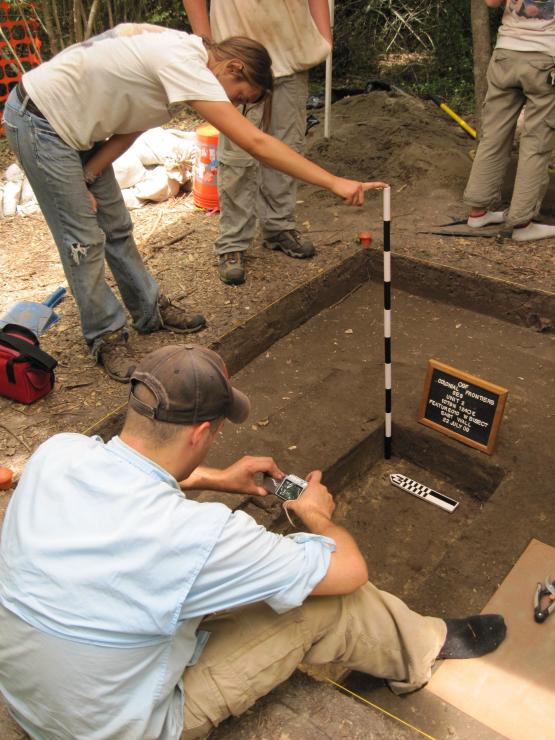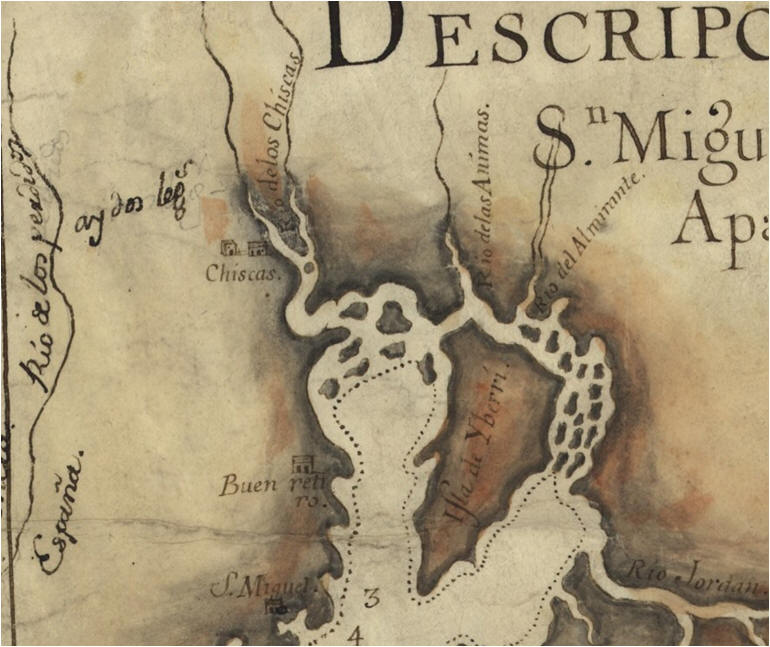
Pensacola Colonial Frontiers Project
See also: Mission Provinces of Spanish Florida / Presidios of Spanish Florida
Despite the fact that the first Spanish presidio established on Pensacola Bay was located in an area which was by that time (1698) largely devoid of indigenous Native American inhabitants, Pensacola's three successive presidios (Santa María, Santa Rosa, and San Miguel) ultimately found themselves neighbored by several immigrant groups living in various distinct communities through the departure of the Spanish in 1763. Among these groups were Apalachee Indians originally native to the Tallahassee region, and who are documented to have arrived in at least two waves, including a first group in 1704 after the destruction of the Apalachee mission province by Creek and English raiders, and a second group in 1718 during the aftermath of the Yamasee War, when Creek Indians withdrew their sole alliance with the English of South Carolina, and many Apalachees living among the Creeks returned to Spanish territory. Yamasee Indians, originally native to eastern Georgia, also arrived in Pensacola after the 1740 English siege on St. Augustine, where they had retreated after the Yamasee War. By the late 1750s, these two groups were living in two distinct mission communities at some distance from the new mainland location of the Spanish presidio at San Miguel (modern Pensacola's downtown). The residents of both these missions engaged in extensive trade and interaction with the Upper Creek Indians of central Alabama, but during the period when they found themselves on opposite sides of the French and Indian War (1756-1763), both missions were burned to the ground in Creek raids during 1761, along with several Spanish ranches.
Though Native American pottery was used extensively by the Spanish residents of all three Pensacola presidios, and has been recovered archaeologically at all sites, as of 2009 none of the documented Apalachee or Yamasee missions had yet been identified and tested archaeologically. During the summer of 2009, the UWF terrestrial archaeological field school under my supervision conducted archaeological survey designed to locate the lost mission site of  San Joseph de Escambe, which was successfully located (see below). During five of the next six summers, UWF terrestrial field schools conducted more extensive excavations at the site; to follow our progress (and also read entries from previous years), see the online blog at the following link: Pensacola Colonial Frontiers: 2009-2025. In addition, a Facebook page for the project is also being maintained and updated with current information.
San Joseph de Escambe, which was successfully located (see below). During five of the next six summers, UWF terrestrial field schools conducted more extensive excavations at the site; to follow our progress (and also read entries from previous years), see the online blog at the following link: Pensacola Colonial Frontiers: 2009-2025. In addition, a Facebook page for the project is also being maintained and updated with current information.
I have also assembled a UWF Field Schools Crew Shot Gallery with group photos of all the students who participated in the terrestrial archaeological field schools I have taught since 2009, including those at Mission San Joseph de Escambe between 2009 and 2015, and in 2025.
The contemporaneous Yamasee mission of San Antonio de Punta Rasa was also located in 2016 during dissertation research by Dr. Patrick Johnson (a veteran of the master's degree program at UWF) at the College of William and Mary.
Additional information on the context for the project is provided below, and will be updated and expanded as time permits.
Missions / Documents / Reports / Press
Selected Pensacola Missions and Nearby Villages
Below are brief descriptions of the most well-documented missions and contemporaneous Native American villages near Pensacola:
Nuestra Señora de la Soledad y San Luís (1718-c1740s) - This Apalachee Indian mission was established in 1718 by the Apalachee chief Juan Marcos Ysfani (also rendered as Fant), and was said to have begun with more 100 inhabitants, including some Apalachee moving back from the vicinity of French Mobile (and probably many who had recently relocated from Creek Indian territory in the aftermath of the 1715 Yamasee War). At that time it was noted to be located five leagues north of Presidio Santa María de Galve along the "Río de los Chiscas" (the Escambia River).
San Joseph de Escambe (c1741-1761) - This Apalachee mission was established upriver along the Escambia River (which actually took its later name from this mission), probably as a relocation of the earlier Apalachee community at the mouth of the river (noted above). At the time it was the northernmost extent of Spanish influence from Pensacola. It was administered by Apalachee chief Juan Marcos Ysfani until its destruction during a Creek raid on April 9, 1761. A Franciscan missionary was stationed here, and a small detachment of Spanish infantry during the 1750s, augmented to include 16 members of a Spanish cavalry unit early in 1760. More details on this mission can be found on the Escambe page, including original documents, such as translations of selected extracts here, as well as a complete transcription of the 1761 investigation into the mission's 1761 destruction here, along with treaties between the Spanish and the Creek Indians framing these hostilities from 1758 and 1761.
San Antonio de Punta Rasa (c1749-1761) - This Yamasee mission was established near Garcon Point when an existing mission community relocated across the bay from an unidentified earlier site near the Spanish outpost at San Miguel de Punta Blanca (later to become the site of the third Spanish presidio on Pensacola Bay, under modern downtown Pensacola). It was administered by Yamasee chief Andrés Escudero until its destruction after an attack by Creek Indians on February 12, 1761. A Franciscan missionary was stationed here, along with several other members of a Spanish infantry unit through the 1750s.
Los Tobases (c1730s, 1759-1761) - This village was the Upper Creek (Tallapoosa Province) settlement nearest to Presidio Santa Rosa in 1738, and after having been abandoned (perhaps after Mission Escambe was established nearby in 1741) the site was resettled by 30 Tallapoosa Indians and their wives and children in early 1759 after a 1758 peace treaty between the Spanish and the Upper Creeks. Situated not far upriver from Escambe, the site was once again abandoned during the 1761 hostilities that resulted in the destruction of both Escambe and Punta Rasa along with all Spanish out-settlements north of Pensacola.
Talacayche (1758-1761) - This Upper Creek village under chief Anatichi was established at the invitation of Governor Miguel Román after the April, 1758 peace treaty between the Spanish and the Creek. It was located 30 leagues east of San Miguel de Panzacola toward the Lower Creek territory, probably on the Choctawhatchee River south of the Florida-Alabama border. Following the February, 1761 murders at Mission Punta Rasa on Garcon Point, Yamasee warriors attacked it in retaliation, after which the site was abandoned.
Punta Rasa II / "Indian Town" (1761-1763) - This short-lived Yamasee-Apalachee community was established adjacent to the Spanish fort at San Miguel during the last stage of the French and Indian War (1756-1763), and was administered by principal chief Andrés Escudero until their voluntary departure with the Spanish for Veracruz, Mexico. In 1763, its inhabitants consisted of 120 individuals, including 18 families ranging in size between 2 and 10 persons, and 21 additional males not associated with larger families. Its location just east of the fort appears to have been recorded by British map-makers after their arrival in 1763, under the name "Indian Town."
Documents
As part of my recent Spanish Florida Document Transcripts page, I have posted several document translations and transcriptions that relate to the Pensacola Colonial Frontiers project, individual links to which are provided below.
|
Reports
Since the search for Mission Escambe began in 2008, a wide range of professional conference papers, publications, and student theses and dissertations have drawn upon the archaeological work conducted as part of the broader Pensacola Colonial Frontiers initiative at UWF, including work at Missions Escambe and Punta Rasa as well as the search for Los Tobases (along with collateral work at the 19th-century Molino Mills sawmill). Below is a list of these reports, including direct links to PDFs online, where available.
Student Theses and Dissertations (most only partly drawing upon Pensacola mission archaeology data)
Danielle Dadiego; Ph.D., Department of Anthropology, University of California, Santa Cruz; "Beads, Bullets, and Brokerage: Exploring Economic Agency in Eighteenth-Century West Florida" (2020)
Krista L. Eschbach; Ph.D., School of Human Evolution and Social Change, Arizona State University: "Mechanisms of Colonial Transformation at the Port of Veracruz and the Northwest Florida Presidios" (2019)
Patrick Johnson, Ph.D., Department of Anthropology, College of William & Mary, Williamsburg, Va.: "Vengeance with Mercy: Changing Traditions and Traditional Practices of Colonial Yamasees" (2018)
Michelle Pigott, M.A., Department of Anthropology, University of West Florida, Pensacola: "The Apalachee after San Luís: Discussing Cultural Hybridization through Ceramic Practice" (2015)
Danielle Dadiego, M.A., Department of Anthropology, University of West Florida, Pensacola: "Spanish Frontiers: A Study of Social and Economic Exchange Networks Present in 18th Century Spanish Missions" (2014)
Joseph Grinnan, M.A., Department of Anthropology, University of West Florida, Pensacola: "Molino Mills Maritime Cultural Landscape of a Reconstruction Era Steam Powered Sawmill in Molino, Florida" (2013)
Patrick Johnson, M.A., Department of Anthropology, University of West Florida, Pensacola: "Apalachee Agency on the Gulf Coast Frontier" (2012)
Presented Papers
Publications
2015 Field School Summaries: 2015 Colonial Frontiers Terrestrial Field School (by Jillian Okray and Melissa Maynard). The Florida Anthropologist 68(3-4): 121-122.
2014 Field School Summaries: 2014 Pensacola Colonial Frontiers Field School (by Michelle Pigott). The Florida Anthropologist 67(4): 203-205.
2012 Field School Summaries: 2012 Mission Escambe Excavations (by Patricia McMahon and Danielle Dadiego). The Florida Anthropologist 65(4): 251–252.
2011 Field School Summaries: 2011 Pensacola Colonial Frontiers Field School (by John E. Worth). The Florida Anthropologist 64(3–4): 281.
2010 Field School Summaries: 2010 Pensacola Colonial Frontiers Project, Mission San Joseph de Escambe (by John E. Worth and Norma J. Harris). The Florida Anthropologist 63(3–4): 197-199.
Press
Below are links to online news items in the press regarding the 2009-2015 and 2025 UWF field schools or other aspects of the Colonial Frontiers project.
NorthEscamia.com, June 30, 2025
Pensacola News Journal, June 24, 2025
Day of Archaeology, June 29, 2012 and part 2
NorthEscambia.com, June 24, 2011
UWF Maritime Archaeology Video Series, June 13, 2011
NorthEscambia.com, June 29, 2009
NorthEscambia.com, July 21, 2009